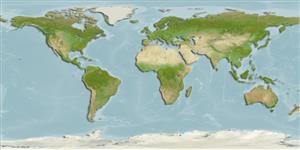Common names from other countries
>
Perciformes/Bembropoidei (Duckbill flatheads) >
Bembropidae (Duckbill flatheads)
Etymology: Bembrops: Greek, bembras, -ados = a kind of anchovy m+ Greek, ops = appearance (Ref. 45335); morelandi: Named for J.M. Moreland of the National Museum of New Zealand..
Environment: milieu / climate zone / depth range / distribution range
Ecologia
marinhas batidemersal; intervalo de profundidade 366 - 395 m (Ref. 13203). Deep-water
Southwest Pacific: known only from New Zealand.
Tamanho / Peso / Idade
Maturity: Lm ? range ? - ? cm
Max length : 20.7 cm SL macho/indeterminado; (Ref. 13203)
Descrição suscinta
Morfologia | Morfometria
Espinhos dorsais (total): 6; Raios dorsais (total): 13-14; Raios anais : 16 - 17. Color in alcohol yellowish gray dorsally, slightly lighter ventrally. Snout relatively long, 1.8x eye diameter. Scales present on lateral and dorsal sides of snout. Upper jaw extending behind anterior margin of eye, almost to the mid-line. Maxillary tentacle long. Lateral line rising sharply above pectoral fin at base for 2-2.5 scale rows and then descending gradually along length of pectoral fin, separated from origin of first dorsal fin by 2 rows of scales, from origin of anal fin by 5, and from insertion of anal fin by 3. First spine of the first dorsal fin prolonged, even in a relatively small specimen. Predorsal length (to first dorsal fin) almost equal to head length. Pectoral fin rounded (Ref 13203).
Holotype taken in 366-395 m.
Ciclo de vida ou comportamento de acasalamento
Maturidade | Reprodução | Desova | Ovos | Fecundidade | Larvas
Das, M.K. and J.S. Nelson, 1996. Revision of the percophid genus Bembrops (Actinopterygii: Perciformes). Bull. Mar. Sci. 59(1):9-44. (Ref. 13203)
Status na Lista Vermelha da UICN (Ref. 130435)
CITES (Ref. 128078)
Not Evaluated
Ameaça para os humanos
Harmless
Uso pelos humanos
Mais informação
Nomes comunsSinônimosMetabolismoPredadoresEcotoxicologiaReproduçãoMaturidadeDesovaFecundidadeOvosDesenvolvimento dos ovos
Idade/TamanhoCrescimentoPeso-comprimentoComprimento-comprimentoFrequências de comprimentoMorfometriaMorfologiaLarvasDinâmica larvalRecrutamentoAbundância
ReferênciasAquaculturaPerfil para aquaculturaEstirpesGenéticaElectrophoresesHereditariedadeDoençasProcessamentoConversão de massa
ColaboradoresFotosStamps, Coins Misc.SonsCiguateraVelocidadeTipo de nataçãoÁrea branquialOtólitosCérebrosVisão
Ferramentas
Relatórios especiais
Baixar XML
Fontes da internet
Estimates based on models
Preferred temperature (Ref.
115969): 8.9 - 11.3, mean 10.8 (based on 6 cells).
Índice de diversidade filogenética (Ref.
82804): PD
50 = 0.5000 [Uniqueness, from 0.5 = low to 2.0 = high].
Bayesian length-weight: a=0.00372 (0.00153 - 0.00904), b=3.10 (2.89 - 3.31), in cm Total Length, based on LWR estimates for this (Sub)family-body shape (Ref.
93245).
Nível Trófico (Ref.
69278): 4.1 ±0.5 se; based on size and trophs of closest relatives
Fishing Vulnerability (Ref.
59153): Low vulnerability (15 of 100).
